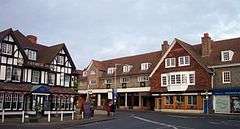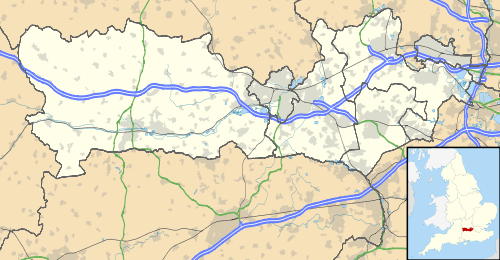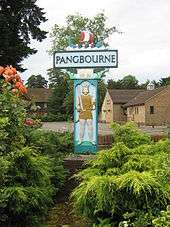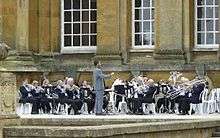Pangbourne
Pangbourne is a large village and civil parish on the River Thames in the English county of Berkshire. Pangbourne has its own shops, schools, a railway station on the Great Western Line and a parish hall. Outside its grouped developed area is an independent school, Pangbourne College.
| Pangbourne | |
|---|---|
 Pangbourne village centre | |
 Pangbourne Location within Berkshire | |
| Area | 6.8 km2 (2.6 sq mi) |
| Population | 2,978 (2011 census)[1] |
| • Density | 438/km2 (1,130/sq mi) |
| OS grid reference | SU6376 |
| Civil parish |
|
| Unitary authority | |
| Ceremonial county | |
| Region | |
| Country | England |
| Sovereign state | United Kingdom |
| Post town | Reading |
| Postcode district | RG8 |
| Dialling code | 0118 |
| Police | Thames Valley |
| Fire | Royal Berkshire |
| Ambulance | South Central |
| UK Parliament | |
Geography
Pangbourne is situated on the A329 road 6 miles (10 km) west of Reading, its nearest town and 22 miles (35 km) south east of Oxford on the River Thames and is across the river from the small developed cluster of the Oxfordshire village of Whitchurch-on-Thames. The two villages are connected by both Whitchurch Bridge and by the traversable weir of Whitchurch Lock, though the latter is not for public use.[2]
Pangbourne railway station is a minor stop on the Great Western Main Line and has stopping services to Oxford via Didcot Parkway and London Paddington via Reading two stops away. The River Pang flows through the centre of Pangbourne village before joining the Thames between Whitchurch Lock and Whitchurch bridge.[2] Its water voles are thought to have inspired author Kenneth Grahame's character Ratty and his book The Wind in the Willows.[3] Most of the developed area is just above the current flood plain of the River Thames which benefits from hay meadows traditionally used as flood meadows to either side of Pangbourne. Fewer than 15 properties here flooded during the Winter storms of 2013–14 in the United Kingdom.
Amenities
Pangbourne has its own shops, primary schools, a railway station on the Great Western Line and a parish hall. Pangbourne has become a centre for selling new and secondhand sports cars with Lamborghini Pangbourne and Aston Martin Reading[4] joining the long-standing Bentley Berkshire dealership as part of the H.R. Owen group. Outside its grouped developed area is an independent school, Pangbourne College.
Demography and land use
| Output area | Homes owned outright | Owned with a loan | Socially rented | Privately rented | Other | km² roads | km² water | km² domestic gardens | Usual residents | km² |
|---|---|---|---|---|---|---|---|---|---|---|
| Civil parish | 478 | 418 | 101 | 187 | 41 | 0.237 | 0.012 | 0.654 | 2978 | 6.8 |
Government

Pangbourne is a civil parish with an elected parish council. The parish covers the immediate agricultural green buffer and a woodland and cultivated south-western area. This rural area contains no other significant settlements and includes Pangbourne College.[5]
The parish shares boundaries with the Berkshire parishes of Purley-on-Thames, Tidmarsh, Sulham, Bradfield and Basildon. Along the River Thames to the north, there is also a boundary with the Oxfordshire parish of Whitchurch-on-Thames.[5]
The parish is in the area of the unitary authority of West Berkshire. The parish council and the unitary authority are responsible for different aspects of local government. Pangbourne forms part of the Reading West parliamentary constituency.
History
Pangbourne's name is recorded from 844[7] as Old English Pegingaburnan (dative case), which means "the stream of the people of [a man called] Pǣga". This name was shortened to make the name of the Pang.
In Norman times, the manor was given to Reading Abbey and the manor house – also called Bere Court – became the Abbot's summer residence. The last abbot, Hugh Cook Faringdon, was arrested there in 1539 and subsequently executed in Reading. The manor was later purchased by Sir John Davis, the Elizabethan mathematician and the Earl of Essex's fellow-conspirator. His monument is in the Church of England parish church of Saint James the Less. The Pangbourne war memorial is found in the grounds of the church.[8] It was designed by the artist Vera Waddington.[9]
Other monuments and hatchments in the church are mostly to the Breedon family. John Breedon Senior bought the manor in 1671. He was High Sheriff of Berkshire and brother of the Governor of Nova Scotia, whose son later succeeded John at the manor. The family produced a number of sheriffs and MPs for Berkshire, as well as doctors and rectors of the parish.[7]
Kenneth Grahame, author of The Wind in the Willows, retired to Church Cottage in Pangbourne. He died there in 1932. E. H. Shepherd's famous illustrations of his book are said to have been inspired by the Thameside landscape there.[7]
The Falkland Islands Memorial Chapel at Pangbourne College was opened by Queen Elizabeth II in March 2000. It was built to commemorate the lives and sacrifice of all who died during the Falklands War of 1982, and the courage of those who served with them to protect the sovereignty of the Falkland Islands.[10] The Queen revisited the Memorial Chapel in 2007 to mark the 25th anniversary of the Falklands war.
To the north-west of the village are wildlife gardens Beale Park and National Trust owned Basildon Park.
Pangbourne and District Silver Band

The history of the Pangbourne Band began in 1893 when a fife and drum band used to rehearse in a shed behind the water mill, but when the First World War broke out the band broke up, re-forming in 1919 after the Armistice. Regular concerts were held from then until the outbreak of the Second World War, when many of the bandsmen served in the Armed Forces and the band again broke up and the instruments were held in storage.
In 1962, Henry Fuller, a local tutor, started the village brass group. Local musicians became involved when the old instruments were recovered from storage, and the band was established as a full-size contesting brass band within a few years.[11] In 2009 in music Pangbourne All-Comers' Band was begun (adults and children) incorporating brass and for parade days drums and bell lyre glockenspiel.
Notes and references
- Notes
- References
- Key Statistics: Dwellings; Quick Statistics: Population Density; Physical Environment: Land Use Survey 2005
- Ordnance Survey (2006). OS Explorer Map 159 – Reading. ISBN 0-319-23730-3.
- Simpson, Aislinn (27 August 2007). "Waterways that inspired literary gems at risk". The Daily Telegraph. p. 11.
- "Aston Martin Reading". HR Owen. Archived from the original on 3 June 2015. Retrieved 2 June 2015.
- "Election Maps". Ordnance Survey. Archived from the original on 7 March 2008. Retrieved 27 February 2008.
- "British towns twinned with French towns". Archant Community Media Ltd. Retrieved 11 July 2013.
- Ford, David Nash (2004). "Pangbourne". Royal Berkshire History. Nash Ford Publishing. Retrieved 25 April 2009.
- "Pangbourne". www.warmemorialsonline.org.uk. Retrieved 29 September 2018.
- "Pangbourne War Memorial". Vera Waddington. 9 April 2016. Retrieved 29 September 2018.
- "The Falklands Island Memorial Chapel". The Trustees of the Falkland Island Memorial Chapel Trust. Archived from the original on 9 August 2008. Retrieved 25 April 2009.
- History – Pangbourne Band Website Retrieved on 17 July 2013.
Further reading
- Ditchfield, P.H.; Page, W.H., eds. (1923). "Pangbourne". A History of the County of Berkshire. Victoria County History. 3. pp. 303–306.CS1 maint: ref=harv (link)
- Pevsner, Nikolaus (1966). Berkshire. The Buildings of England. Harmondsworth: Penguin Books. pp. 191–192.CS1 maint: ref=harv (link)
External links
| Wikimedia Commons has media related to Pangbourne. |
| Wikivoyage has a travel guide for Pangbourne. |
≈